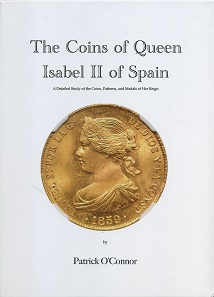by Ursula Kampmann
translated by Annika Backe
October 19, 2017 – When you think of Isabel of Spain, you immediately envision that independent woman of the early modern era who found herself a husband to secure her dominion over Castile. But this isn’t the Isabel we mean. In the 19th century, there was a queen of the same name, who, from a formal point of view, ruled for an even longer period of time than her namesake.
Patrick O’Connor, The Coins of Queen Isabel II of Spain. A Detailed Study of the Coins, Patterns, and Medals of Her Reign. Aurora Rarities LLC, San Antonio 2017. 294 pages, color illustrations throughout, hardcover, 22.2 x 28.7 cm. ISBN: 978-0-9991616-0-9. US$ 135.
Isabel II came to the throne in 1830, at the tender age of 3 after her father had set aside the Salic Law specifically for her. At the age of 13, she was declared of legal age. Times were hard, though, the 19th century being an era of upheaval that confronted the ones in power with nearly impossible challenges. Unable to cope, too, Isabel was forced to leave her country in 1868 as a result of a revolt. She fled to France and renounced the throne in favor of her son in 1870. She was to live for nearly a quarter of a century in Paris.
It is a long life, a long reign, and a variety of coins with which Patrick O’ Connor deals keenly. As a US-American, who of course began his life as a collector by assembling American coins he was fascinated by the fact that there is hardly anything known about the coinage of the Spanish Queen Isabel II. So he answered his own questions and now, with his book, takes the reader on a fascinating expedition.
The volume kicks off with a part on history, highlighting both the Spanish history during Isabel’s reign and her own life. Only then does Patrick O’Connor begin reconstructing the numismatic history, based on the English translations of the royal edicts. In another chapter, he assembles the information available on the mints, the die cutters and assayers working in Isabel’s time. This part of the book is rounded out by a wealth of good advice from a collector to help other collectors familiarize with this field.
The catalog is next. It is arranged according to four periods the author has established with the help of the minting ordinances. Within these periods, the varying denominations are listed, starting with the lowest. Every type is accompanied by an illustration and a short description – the edge lettering is also given, but not the legend. The technical data, on the other hand, is noted down to the smallest detail. The years of issue and the mints are listed in a table. Every combination has been assigned its own number which reflects the coin – consisting of denomination, year of issue, and mint – but doesn’t necessarily facilitate the search of a cited coin in the catalog. Anybody looking up a coin on the basis of a citation will surely miss the consecutive numbering badly.
As far as it is known, the author gives a mintage for every emission. He specifies the rarity and states indicative prices for the major grades, based on the American system, of course. Patrick O’Connor also made sure to provide a concordance with the most important standard references.
Adding to the coins, the author catalogs the patterns and medals as well as several fantasies. The latter are of great numismatic interest, and we point to early precursors to what we know from modern numismatics: To accommodate the collectors, private mints struck coins that virtually surpassed the originals in beauty, thus meeting a demand of the collectors.
Although one might wish that the author would have made sure that the individual coins are easier to find – for instance, it would be useful if the table of contents stated the pages of the different parts of the catalog –, Patrick O’Connor’s compilation of material proves extremely valuable. With the help of the information he gathered, the reader understands how the coinage system worked under Isabel II. O’Connor thus makes an important contribution to the Spanish monetary history of the 19th century. Furthermore, he presents the coin trade with a new catalog that will soon become the standard reference, even if some hurried users will curse like a sailor when accessing it.
You can order the book for $135 at Kolbe & Fanning.





